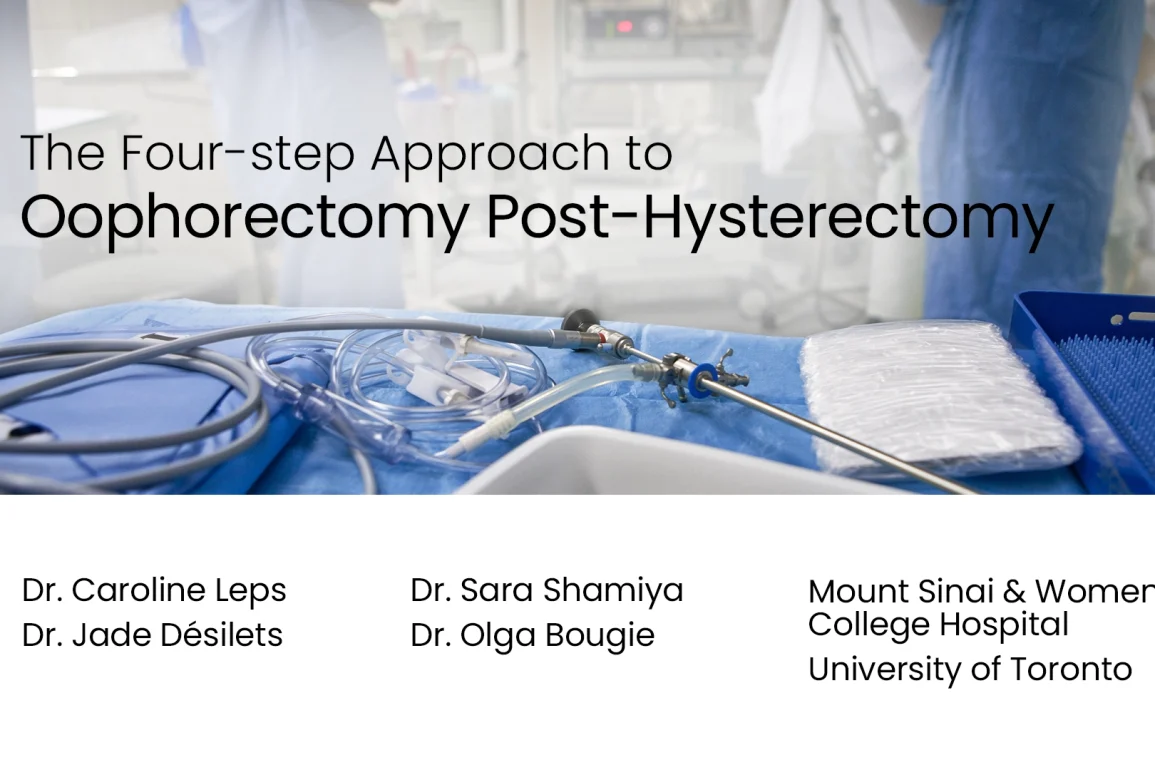Table of Contents
- Procedure Summary
- Authors
- YouTube Video
- What is the Four-step Approach to Oophorectomy Post-Hysterectomy?
- What are the Risks of the Four-step Approach to Oophorectomy Post-Hysterectomy?
- Video Transcript
Video Description
A clear four-step laparoscopic approach to oophorectomy after hysterectomy, highlighting key anatomical landmarks, dissection tips, and surgical efficiency.
Presented By




Affiliations
Mount Sinai & Women’s College Hospital, University of Toronto
Watch on YouTube
Click here to watch this video on YouTube
What is The Four-step Approach to Oophorectomy Post-Hysterectomy?
The four-step approach to oophorectomy post-hysterectomy is a structured laparoscopic technique for safely removing an ovary after the uterus has been removed, when distorted anatomy and adhesions increase surgical complexity. Here’s what it involves:
- General Survey and Adhesiolysis: A complete pelvic inspection is performed and bowel adhesions are sharply and bluntly dissected to expose the pelvic sidewall and locate the ovary.
- Retroperitoneal Entry and Ureterolysis: The retroperitoneum is opened and the ureter identified and mobilized to protect it throughout the procedure.
- Infundibulopelvic Ligament Control: The infundibulopelvic ligament containing the ovarian vessels is skeletonized, sealed with electrosurgery, and transected to secure blood supply.
- Ovary Excision: With vascular control established, the ovary is dissected free from the pelvic sidewall using sharp and blunt techniques to ensure complete removal without leaving remnants.
This method provides a reproducible, stepwise pathway that protects critical structures and allows complete ovarian resection even in cases with dense adhesions.
What are the Risks of the Four-step Approach to Oophorectomy Post-Hysterectomy?
Oophorectomy after hysterectomy carries significant risks despite a structured approach. These include:
- Ureteral Injury: The ureter lies close to the infundibulopelvic ligament and is at risk during retroperitoneal dissection and vascular control.
- Bowel or Bladder Injury: Dense adhesions can tether bowel or bladder to the pelvic sidewall, increasing the risk of perforation during adhesiolysis or excision.
- Vascular Complications: Injury to the infundibulopelvic ligament or pelvic sidewall vessels can cause major hemorrhage requiring transfusion or conversion to open surgery.
- Infection and Abscess: Adhesiolysis and retroperitoneal dissection increase the potential for postoperative infection or pelvic abscess.
- Incomplete Resection: Failure to remove all ovarian tissue can result in ovarian remnant syndrome with ongoing symptoms or cancer risk.
Careful adherence to each step – systematic dissection, clear identification of the ureter, controlled vessel sealing, and meticulous excision—helps minimize these complications and supports safe, complete ovary removal.
Video Transcript:
The four-step approach to oophorectomy post hysterectomy. We have no relevant disclosures. The objectives of this video are to, one, review common surgical encounters after hysterectomy, and, two, demonstrate a simplified four-step approach to resecting an ovary post hysterectomy.
The hysterectomy is the sixth most common surgery performed in Canada. Approximately 9% of people post hysterectomy will require repeat surgery later in life to remove the ovaries, which may present a surgical challenge. Oophorectomy post hysterectomy is often a more complex procedure than when the uterus is in situ, even when done for ovarian cysts that are not associated with adhesion formation.
Post hysterectomy, the ovaries are often found in the retroperitoneum and behind bowel adhesions. As such, a systematic approach is required for safety of critical structures and to ensure no ovarian remnant is left behind. Preoperative planning requires a review of the patient’s past medical history, past surgical history, and, if available, the previous operative note. Imaging may help identify ovarian location and mobility.
Our case was a 41-year-old G1P1, seeking a nephrectomy for a left ovarian cyst. Her past surgical history was notable for a laparoscopic hysterectomy for adenomyosis and a right oophorectomy for a haemorrhagic cyst. Her previous operative note reported dense pelvic adhesions. An MRI demonstrated ovarian lesions and an ovary high in the left lower quadrant.
We will now demonstrate the four-step approach to oophorectomy post hysterectomy. The steps are, one, perform a general survey and take down adhesions, two, enter the retroperitoneum and perform ureterolysis, three, skeletonise the infundibulopelvic ligament, seal, and transect, and, four, excise the ovary off of the pelvic sidewall.
We will now demonstrate these steps in turn. Step one, perform a general survey and take down adhesions. Upon entering the pelvis, we pan from the right to left lower quadrant and notice filmy adhesions between the bowel and the left pelvic sidewall. In order to access the pelvic sidewall and the ovary, these adhesions were taken down with a combination of sharp and blunt dissection. We continued to lyse the adhesions, medialising the bowel until the ovary was seen through the left pelvic sidewall.
Having identified the ovary, we then freed the bowel inferiorly, using a combination of sharp and blunt dissection. This revealed the pelvic sidewall.
We now begin step two, enter the retroperitoneum and perform ureterolysis. The ureter was identified through the parietal peritoneum, just below the pelvic brim, where it enters the pelvis by crossing anterior to the bifurcation of the common iliac vessels and courses caudally along the medial leaf of the broad ligament. We then enter the retroperitoneum, superior to the ureter, using a blunt technique. In cases where the pelvic sidewall is inaccessible, a lateral approach can be used. We then identify the ureter on the medial leaf of the retroperitoneum.
With the ureter identified, we begin step three, skeletonise the infundibulopelvic ligament, seal, and transect. We then began to skeletonise the infundibulopelvic ligament with a combination of sharp and blunt dissection. We began superiorly and then worked our way down its medial and lateral aspects. Throughout this dissection, we ensured that we were well away from the ureter. With the infundibulopelvic ligament free from its attachments and critical structures it was sealed with electrosurgery and transected.
We now begin step four and excise the ovary off of the pelvic sidewall. With the ovary free of its blood supply, we began to excise it off of the pelvic sidewall, with a combination of sharp and blunt dissection and electrosurgery.
We will now demonstrate the four-step approach in a second case. Our second case was a 61-year-old G0 BRCA2 carrier. Her past medical history was notable for breast cancer. Her past surgical history included a total abdominal hysterectomy for heavy menstrual bleeding. She was seeking a risk reducing bilateral oophorectomy. In this case, it is critical to ensure that no ovarian remnant is left behind.
We begin with step one, and perform a general survey in lysis of adhesions. In this case, we were unable to see the ovary in the retroperitoneum or the pelvic sidewall. As such, we begin step two, and enter the retro peritoneum using a lateral approach. With a combination of sharp and blunt dissection, we dissected in the retroperitoneum. To find the ureter, we traced its course, cephalon [?] in the pelvis, starting at the bifurcation of the common iliac.
To begin step three, we must identify the infundibulopelvic ligament using anatomic landmarks. In this case, it was found superior to the ureter on the medial leaf of the retroperitoneum. To ensure no ovarian remnant was left behind, the infundibulopelvic ligament was sealed with electrosurgery intersected two to 3 cm from the ovary per risk-reducing protocol. In cases with significant adhesions, the ovary may be difficult to identify. It can be found by tracing the infundibulopelvic ligament.
We then begin step four, and excise the ovary off the pelvic sidewall. In this case, we notice dense adhesions anteriorly and posteriorly. In cases such as this, certain techniques can be used to delineate critical structures. Techniques include developing the paravesical or pararectal space, using a vaginal or bowel probe, or retrofilling the bladder.
Here, we demonstrate cystic inflation to ensure that the bladder is far away from the ovary’s anterior attachments. Knowing that the bladder was far from the surgical field, we then began to release the anterior adhesions and the ovary’s medial and caudal attachments. We are now left with the ovary’s inferior attachments close to the bowel. These were taken down with a combination of sharp and blunt dissection.
Although we were confident that the bowel was far from the surgical field, in cases of uncertainty a bowel probe can be used. With the bowel now far from the surgical field, we began to use electrosurgery.
In summary, the four-step approach to oophorectomy post hysterectomy allows for a systematic dissection, helping ensure no ovarian remnant is left behind, and safety of critical structures. This approach can be applied in simple and complex cases.


